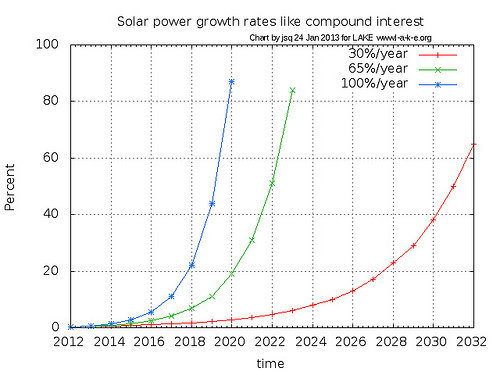Some nuclear backers only want to look at the next table in that FERC report, Office of Energy Projects Energy Infrastructure Update For December 2012, which shows solar energy as 0.34% of total U.S. energy production, and then they stop thinking. But what about that 30% increase in solar power deployed between 2011 and 2012? Think of it like compound interest.
| Installed Capacity (GW) | % of Total Capacity | % Growth 2011-2012 | |
|---|---|---|---|
| Coal | 337.71 | 29.17% | 1.3% |
| Natural Gas | 491.82 | 42.48% | 1.8% |
| Nuclear | 107.01 | 9.24% | 0.1% |
| Oil | 41.32 | 3.57% | 0.1% |
| Water | 98.12 | 8.47% | 0.1% |
| Wind | 57.53 | 4.97% | 22.8% |
| Biomass | 15.00 | 1.30% | 3.7% |
| Geothermal Steam | 3.70 | 0.32% | 4.2% |
| Solar | 3.90 | 0.34% | 60.9% |
| Waste Heat | 0.69 | 0.06% | 0.4% |
| Other | 1.04 | 0.09% | 0.0% |
| Total | 1,157.86 | 100.00% | 23.3% |
Source: Data derived from Ventyx Global LLC, Velocity Suite.
Growth rates computed by jsq for LAKE www.l-a-k-e.org 24 January 2013.
Let’s look what happens if we assume 30% growth in solar power deployed per year:
At 30% annual growth, we’re up to solar as 50% of all generation within twenty years. That’s impressive, but still too slow to, for example, affect climate change fast enough to make much difference.
But 30% isn’t actually the growth rate. 30% is the increase in added solar capacity between 2011 and 2012. So 30% is actually the acceleration in growth, compared to linear growth. But solar power growth is not linear; we’re not adding the same number of solar MW each year: we’re adding an increasing amount each year, 30% more added in 2012 than was added in 2011. That’s not linear growth: that’s compound growth, like money in the bank with compound interest. Very large interest.
What’s the real growth rate?
Since 1.476 gigawatts of solar power were added in 2012,
for a total of 3.9 GW, the total in 2011 must have been 3.9 – 1.476 = 2.424 GW.
So the growth rate from 2011 to 2012 was 3.9/2.424 = 1.6089, or about 61%.
 Which is quite similar to the
65% average annual growth rate from
2005 to 2010 observed by Paula Mintz of Navigant.
That’s the realistic middle curve on the graph:
65% annual growth.
Which is quite similar to the
65% average annual growth rate from
2005 to 2010 observed by Paula Mintz of Navigant.
That’s the realistic middle curve on the graph:
65% annual growth.
However, that middle curve is only realistic in the current sceptical political and financial climate for solar power. What if we added Feed-In Tariffs, or a carbon tax? That solar power growth rate would go up.
The third curve on the graph shows what happens with 100% annual growth rate. We’d break 20% in six years from now and we’d have enough solar power to run the whole country in less than ten years.
You may say that’s silly: that graph shows growth as a percentage of total power generated, and is drawn like everything but solar is standing still. Well, look at the growth rates in the table! The only thing other than solar cracking 5% growth is… wind power. Which means even at the 65% solar growth rate we can power the country mostly on wind and solar in less than a decade if we want to. And long before then we can start shutting down not just coal and nuclear plants, but also natural gas plants.
Now obviously growth rates like that have to slow down eventually, because otherwise we end up generating more than 100% and customers will stop buying more. However, with Moore’s Law for solar there’s no reason we can’t do 65% for quite some time. Or faster. And there are lots of countries in the world beyond the U.S.
Well, no reason except financing and legal obstacles like
Georgia’s 1973 Territorial Electric Service Act.
The GA legislature
is in session and could fix that last right now.
That would help with financing.
So would a Feed-In Tariff or a carbon tax.
 Or the legislature could just fully fund GEFA’s 35% state renewable
energy tax credit.
And double the pot like it did
year before last.
Or the legislature could just fully fund GEFA’s 35% state renewable
energy tax credit.
And double the pot like it did
year before last.
I know some people will say we shouldn’t subsidize any new sources of energy, but many of them are the same people who are backing nuclear with its huge subsidies, and the rest could do more to stop the ridiculous subsidies fossil fuel companies still get even though they are now among the most profitable companies in the history of the planet. Governments have always subsidized new sources of energy, and solar and wind should be no exceptions. But the first thing the Georgia government could do is stop getting in the way: fix that 1973 law.
-jsq
Short Link:
